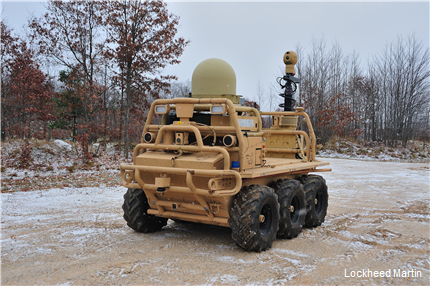Army, Lockheed to test drones-only mission, by air and land
Unmanned ground and aircraft vehicles will work together to carry out a surveillance/targeting scenario.

The U.S. Army Robotics Technology Consortium has awarded a contract to Lockheed Martin to conduct a fully autonomous reconnaissance, surveillance and target acquisition mission experiment. The cooperative test will feature Lockheed’s Squad Mission Support System (SMSS) unmanned ground vehicle and the K-MAX unmanned air vehicle working together, Lockheed announced.
Working with the U.S. Army Tank Automotive Research, Development, and Engineering Center (TARDEC), the scenario will involve a K-MAX autonomous helicopter transporting an SMSS into an “area of interest” too dangerous for human surveillance. The UAV will autonomously set down over a designated coordinate and release the SMSS.
The SMSS, which is equipped sensors, satellite communications equipment and a Gyrocam, will then survey the area using both autonomous capabilities and teleoperation while the K-MAX returns to base. The Gyrocam 9M Tactical Surveillance System provides high-resolution electro-optical video while on the move.
“This level of mission cooperation between unmanned air and ground vehicles of this size, controlled beyond line-of-sight, is an industry first,” said Joe Zinecker, director of combat maneuver systems at Lockheed Martin Missiles and Fire Control. “We believe this demonstration could lead to expanded missions, such as remote sensing and monitoring of suspected chemical, biological, radiological, nuclear and explosive threats or events.”
Target acquisition, reconnaissance and surveillance sensors on-board the SMSS will be used to locate and observe targets and objects of interest. The raw sensory data will then be analyzed hundreds of miles away through the use of satellite communications.
The experiment will push the surveillance capabilities of the SMSS, which is the largest unmanned vehicle to be deployed with U.S. ground forces, according to Lockheed. Originally designed to provide unmanned transport and logistical support capabilities for special operations forces, the SMSS is envisioned to have armed variants and enhanced reconnaissance and surveillance capabilities in the future.
Meanwhile, the K-MAX, designed as a power lift helicopter capable of autonomous or remote controlled cargo delivery, will use its sling load to carry the 2,000-pound SMSS. The system is capable of delivering a full 6,000 pounds of cargo at sea level and more than 4,000 pounds at an altitude of 15,000 feet, and is currently in use by the construction and logging industries.
The experiment will showcase cooperation between different unmanned systems and follows a string of unmanned vehicle tests as capabilities continue to improve. The current scenario will act as a follow-up to a previous test that was conducted in 2012, in which the SMSS used beyond line-of sight satellite communications to autonomously conduct a simulated surveillance mission.
successfully demonstratedNEXT STORY: DARPA looks to upgrade space junk monitoring



